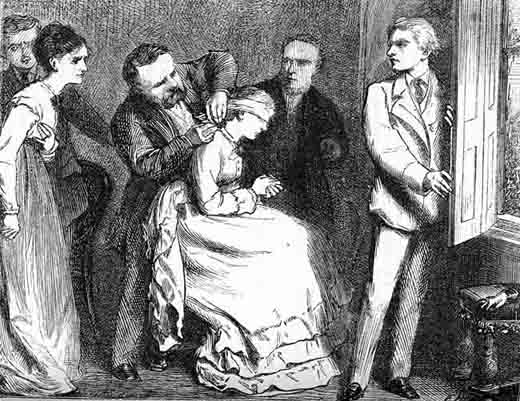Dear Serial Readers,
Picking up on Kari's comment about the good clergyman Cleves at the end of "Amos Barton," I find this story also recommends a model of the kind vicar who can make meaningful connections to his parish flock and isn't wedded to doctrinal principles. I see seeds of future Eliotic ministers in Maynard Gilfil--the generous Dr. Kenn in THE MILL ON THE FLOSS, the warm and intuitive Farebrother in MIDDLEMARCH, to name only a few.
While I can hear some of you SRs groaning about the plodding plot, the overwrought descriptions of Cheverel Manor (supposedly modeled on Arbury Hall, where Eliot's father Robert Evans was estate agent when she was a child), I do find interesting the narrative structure in this story. It works backwards from the time of "Amos Barton," as the opening mentions "old Mr. Gilfil died" thirty years earlier. Then we see the later years of Mr. Gilfil as the vicar who doesn't "shine in the more spiritual functions of his office" yet seems a better clergyman for all that then poor Amos B. The first chapter of this story concludes with hints about the love story of the vicar's now "wifeless existence" and the second chapter goes back several decades more to 1788 and young Gilfil's unrequited love for Caterina who is in love with the seductive Captain Wybrow who apparently has no intention of marrying her. I like this backward motion, even from "Amos Barton" to this story, and then again within this story. Eliot's interest in how to write the past surfaces in these early stories. But as for seriality, it's subtle perhaps.
Next time: chaps. 3-6 of "Mr. Gilfil's Love-Story."
Serially yours,
Susan

2 comments:
One could trace the action in these chapters simply by following the appearance of cushions. No light weight, Eliot, young writer or old. Wise asides on human nature throughout and wonderful images--“She paced up and down in the moonlight, her pale face and thin white-robed form making her look like the ghost of some former Lady Cheverel come to revisit the glimpses of the moon.” I doubt she describes for the sake of filling pages. Take the “unshaded window” in the drawing room, “…the walls hung with full-length portraits of knights and dames in scarlet.” She’s reflecting Caterina’s interior mood and quite aptly setting the scene for Caterina’s singing the airs of yearning and lost love, which “came very close to Caterina’s own feeling.”
The descriptions of setting may go on a bit long (even worse than Mansfield Park!) but I agree with readerann that they serve to describe characters.
Post a Comment